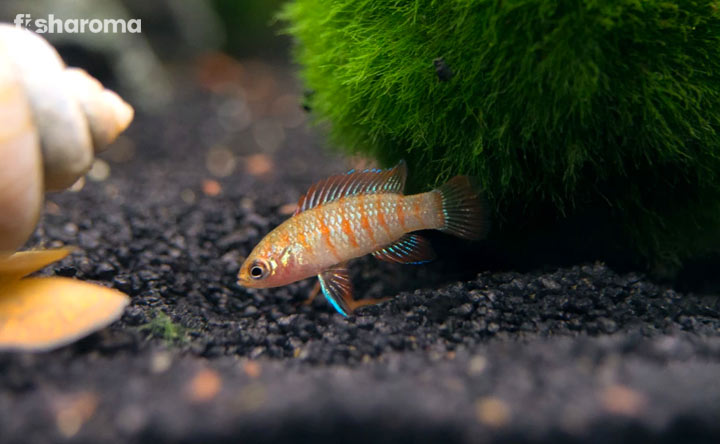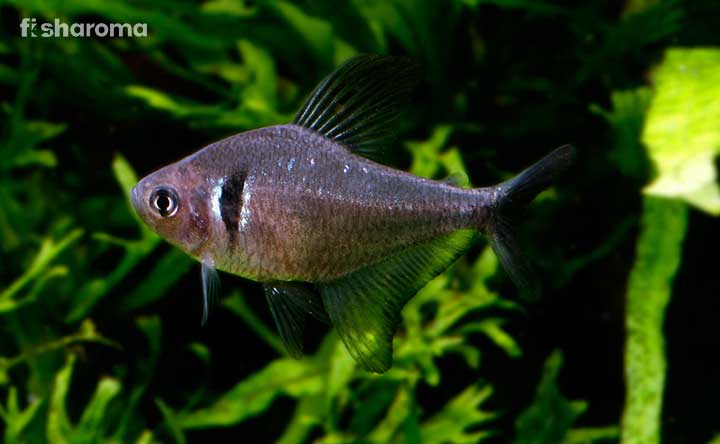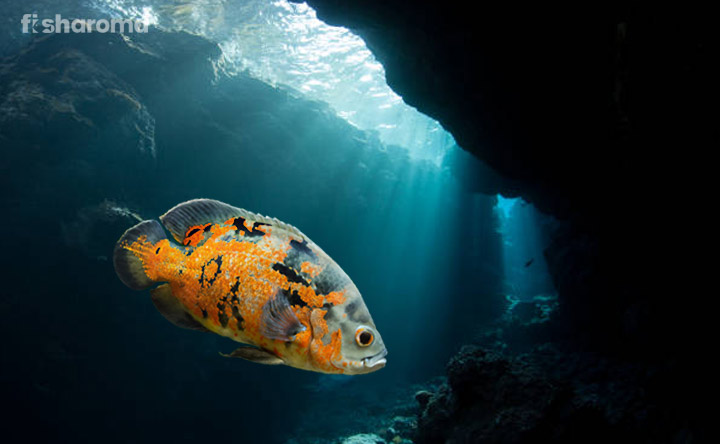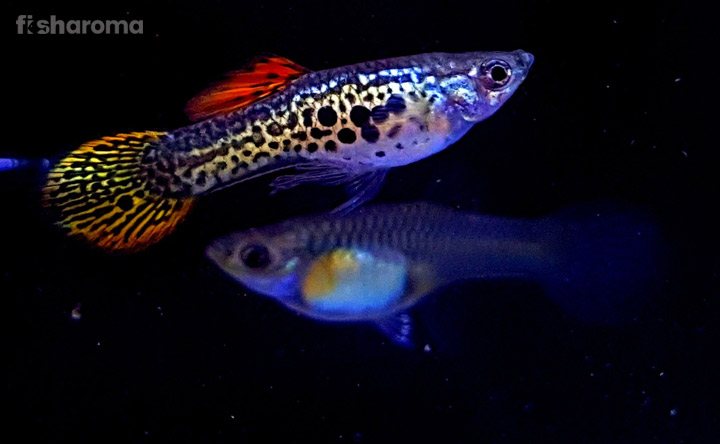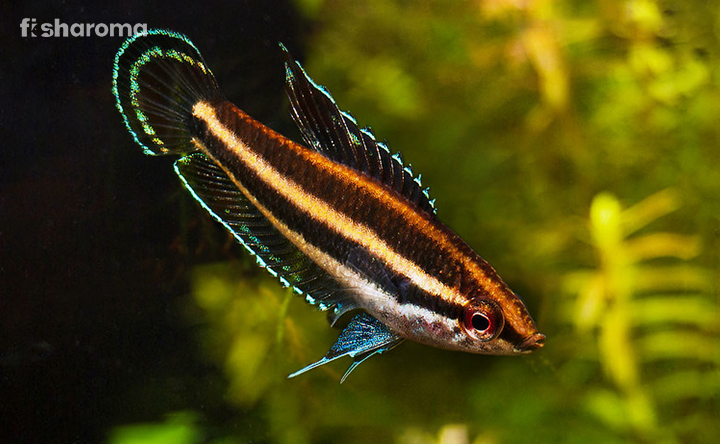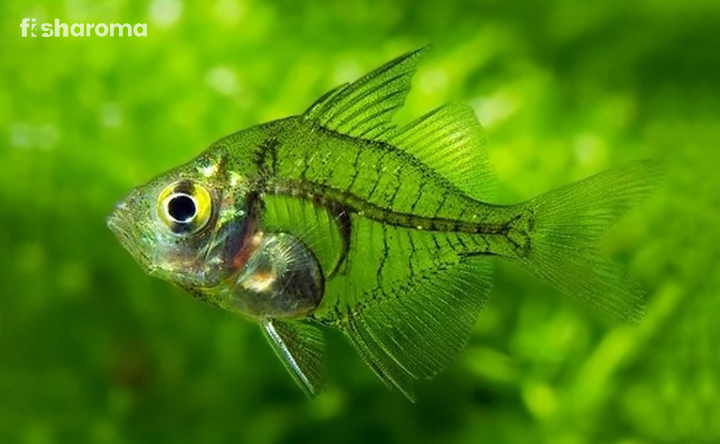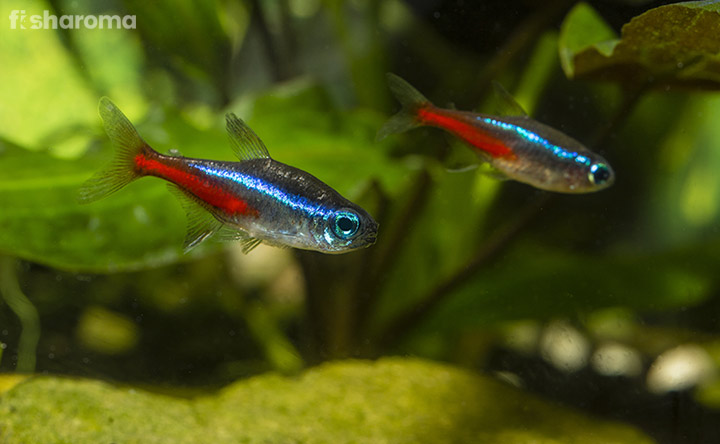Jaguar Cichlid- A Care Guide To This Gorgeously Patterned Beauty
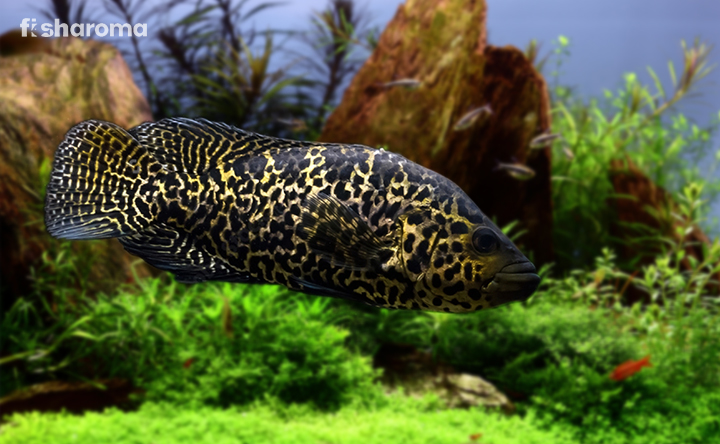
- Origin & Habitat of Jaguar Cichlid
- Appearance of Jaguar Cichlid
- Behaviour of Jaguar Cichlid
- Lifespan of Jaguar Cichlid
- Diet of Jaguar Cichlid
- Tank Requirements for Jaguar Cichlid
- Water Type for Jaguar Cichlid
- Compatibility of Jaguar Cichlid
- Breeding of Jaguar Cichlid
- Disease and Treatment of Jaguar Cichlid
- Summary
Jaguar Cichlids, also known as Managuense, are a popular choice among most aquarists. They are freshwater fishes and are stunningly beautiful. They belong to the Actinopterygii class and the Cichliformes order.
Since the fish can get quite large in size, you should make sure that you take proper care of their needs.
So, if you are looking forward to adding this beautiful fish to your aquarium then, you’re at the right place. They would make a great company and their presence will light up your tank. Here, we will discuss their care guide, diet, behaviour, breeding and other fascinating facts. Follow through, to know it all!
Key Specifications of Jaguar Cichlid
Jaguar Cichlid is a great option if you are considering getting a stunningly hued pet fish for your aquarium. So, let’s have a look at some of their chief characteristic traits.
| Scientific Name | Parachromis managuensis |
| Common Names | Jaguar fish, Managuense Cichlid, Managua Cichlid, Guapote, Aztec Cichlid, Spotted Guapote, Jaguar Guapote, Jag fish, Leopard Cichlid |
| Origin | Central America |
| Lifespan | About 15 years |
| Colour | Silver or golden coat dotted with black spots |
| Temperament | Aggressive, Predatory |
| Size | 15-23 inches |
| Diet | Carnivore |
| Family | Cichlidae |
| Compatibility | Same species and other cichlid species |
| Tank Size | 30 Gallon for the juvenile; 70-100 gallons for a single adult |
| Care Level | Moderate |
| Water Temperature | 22-28 Degrees Celsius |
| Water Conditions | pH 7-8 |
| Breeding | Egg-layer |
Overview
Jaguar Cichlids (Parachromis managuensis) are enormous in size and they are raptorial in nature. They are extremely beautiful and they develop distinct patterns on their skin when they are in the reproductive phase. These fishes thrive in the freshwater habitat and love to dive through fast-moving streams. These fishes are quite hardy and can live in a variety of environmental conditions, which include thick vegetation and even low oxygen concentration.
These species of Cichlids are very interesting and you would love to accept the challenge of keeping them as your pet. However, you must pay heed to their lifestyle and necessities.
Origin and Habitat of Jaguar Cichlid
In 1867, Gunther first caught sight of these fishes in Lake Managua in Nicaragua. These fishes most popularly inhabit Central American lakes, basins and rivers. Originally they also inhabit the lakes of Honduras and Costa Rica.
These fishes are also found widely in the Matina river, Costa Rica and River Ulua in Honduras. Due to the escalating fish keeping trade and importations, these fishes have also found their suitable homes in places like the US, Mexico, Singapore, Guatemala, Salvador, and Panama. Jaguar Cichlids thrive in freshwater rivers and brooks, which are warm and have a neutral pH.
Appearance of Jaguar Cichlid
Jaguar Cichlids are spectacularly attractive species of fishes. They are large and have elongated body frames with striking fins. They look flat and oval-shaped from the side and from the top, they appear sleek and slender. This morphology helps them to swim faster.
The dorsal and anal fins of these fishes are dragged backwards and are braced by rigid spines. These spines serve as a shield and defend the fishes from other predators.
Jaguar Cichlids also have gaping mouths with honed incisors on the lower lip. Their bottom jaws can extend in size to catch prey and they have four sharp incisors attached to them. Additionally, these fishes also have a set of teeth on their pharynx, which is located in their throats.
The male fishes have a more defined body structure than the female ones. They are visibly more oval in shape and elongated in size. The female fishes have a round belly which gets more prominent during the breeding season as they carry the eggs.
Size
Jaguar Cichlids are known for their tremendous ability to grow in size. When in captivity, they can grow up to 15 inches. Male Jaguar Cichlids can reach up to 14 inches in size, while the female ones are usually about 12 inches long. With heedful care and maintenance, you can expect further growth in their size and weight.
In their native environment, these fishes can even get larger in size reaching 23 inches and weighing up to 3.5 pounds.
Jaguar cichlids have a high growth rate. Within the time span of two months, they can reach up to 6 inches. A one and a half year old Jaguar Cichlid is almost 15 inches long.
A he-cichlid is typically more elongated and oval-shaped. Whereas, a female Jaguar Cichlid has a distinctive sphere-shaped belly. During the breeding season, a female Jaguar Cichlid’s rounded belly becomes even more pronounced as it contains eggs. You’ll notice that their bellies will swell even more during the mating season as they will harbour the eggs.
Colour
Jaguar Cichlids are usually found to be silver in colour. However, some also have golden or bronze coloured coats. You can also find light bluish-green tinted coats on some of the fishes.
The distinguishing feature of a Jaguar Cichlid is the dark black blobs on their skin. You will find a resemblance with the stripes on a Jaguar and hence, the name. These black splotches appear as continuous vertical bands on the juvenile fishes. However, as they grow in size, the bands separate into big, black blobs.
You will also notice that two dark stripes mark the back of their eyes. As the fishes age, the male ones shed off these stripes to display the dark black blotches. Most females will however retain these stripes even after they age.
The usual pattern of these blotches is horizontal. They extend straight from their backs to the tails. However, you may also find many Jaguar Cichlids with different splotch patterns.
Behaviour of Jaguar Cichlid
If you are planning to get this beauty for your tank, then the first thing that you should acknowledge is their aggressive and predatory behaviour. They are highly territorial in nature and so, will see any foreigner as a warning.
They don’t prefer to live in communities. Although juvenile Cichlids are societal, they start manifesting belligerent behaviour once they mature. So, you should pay keen attention to the tank mates that you’d choose for them.
As we have mentioned earlier, these fishes can live fairly peacefully with other Jaguar Cichlids or other species of Cichlids. However, note that if you want more than one cichlid in your tank then, you should raise them together. They should also be similar in size. These measures will stop them from attacking one another.
You should also make sure to provide them with an abundant area to swim since they are very active, mostly during the day. Jaguar Cichlids like to spend hours at the bottom of the tank, digging and nibbling around in the substrate. When the night comes, you will find them resting calmly on top of the tank substrate.
Lifespan of Jaguar Cichlid
Jaguar Cichlids can live up to 15 long years! So yes, if you are looking forward to introducing a Jaguar Cichlid to your aquarium then, that’ll be a great idea! Jaguar Cichlids are aquarist-friendly and will accompany you for 15 long years!
Also, quite amazingly, they can cross the 15 years mark and live longer if you diligently take care of them and set up the optimal tank conditions.
Diet of Jaguar Cichlid
Jaguar Cichlids are carnivores and they love flesh. If you introduce smaller or peaceful fishes in your tank then, expect a bad outcome as a Jaguar Cichlid fights till its prey dies. They are great feeders and if you do not pay attention to their diet and mealtime, they can turn more aggressive. So, make sure to keep an eye on their feeding routine.
They Prey on:
- Smaller fishes (Swordfish)
- Cut up fish (Crayfish)
- Goldfish
- Tadpoles
Commercially Available Fish Food:
- Frozen Food
- Dry Food
- Fish Pellet
- Sinking Pellet
- Beef Heart
They Also Feed on Macroinvertebrates:
- Bloodworms
- Earthworms
- Crickets
- Brine-shrimp
You should nourish your pet Cichlid once a day. Make sure that you don’t overfeed them as it may cause bloating and gastrointestinal issues. To ensure active metabolism, you can starve them for one day once a week. Do keep in mind that their diet should be rich in protein and vitamins.
Their diet should include a sparse quantity of chopped meat, like beef or pork as they contain high-fat content and may harm the fishes.
Tank Requirements for Jaguar Cichlid
If you are considering having Jaguar Cichlids as your pet then, you must assiduously take care of their needs and properly maintain the aquarium. Here we will help you out with an easy yet expert care guide for these beautiful species of fishes. Get detailed guidance on setting up a fish tank.
Their diet should include a sparse quantity of chopped meat, like beef or pork as they contain high-fat content and may harm the fishes.
Tank Size
Since Jaguar Cichlids can get quite large in size (about 16 inches), they should be ideally kept in a 100 to 125 gallons tank. For a juvenile Cichlid, you can get a 30 gallons tank, but they will grow in no time so, eventually, you will need a larger tank to accommodate them.
If you plan on getting your fish pet another Cichlid mate then, you should increase the tank size to about 180 gallons. The more the number of cichlids in your tank, the greater should be the tank dimensions.
Jaguar Cichlids are inquisitive critters and so, they require enough space to swim around and explore things. Also, since they are quite truculent in nature, keeping your Cichlid with one of their own kind won’t inevitably stop them from starting a fight. Therefore, it’s always recommended that you choose a sizable tank to give them enough personal space.
Tank Shape
Make sure that you pay heed to the fact that Jaguar Cichlids are curious and love to roam around freely. So, any aquarium shape would go well with them as long as they are getting adequate space and freedom.
You need to avoid those narrow rectangular tanks as they may make the fish feel claustrophobic and restricted.
Tank Lid
Tank Lids are important especially when it comes to Jaguar Cichlids. They have a tendency to jump high and hence, a tank lid is a must as it will prevent them from falling out of the tank and ultimately suffocating to death.
Moreover, tank lids protect the aquarium environment from dust particles and harmful foreign substances.
You need to ensure that the tank lid is tightly closed.
Substrate
For Jaguar Cichlids, you should include sufficient substrate on the bottom of the tank. These fishes are popular bottom diggers and they love spending time at the base of the tank.
You can add a thick layer of sand for them to dig in and play. The most recommended substrate for Jaguar Cichlids is dark-grained gravel.
You should avoid adding rough stones and rocks on the bottom as it may bruise the fish’s skin and cause injury. Also, make sure that the rocks you put on the bottom are not the size of their mouths. You don’t want your fish to gulp them down and choke.
Filter
Filters are necessary for aquariums. They purify the water thus helping the fishes breathe fresh air. Jaguar Cichlids excrete a fair amount of waste so, the most recommended types of filters for them are sump filters with heaters or canister filters.
Canister filters ensure low levels of ammonia and nitrate production from waste. These chemicals in excess can harm your fish.
Ornaments
For Jaguar Cichlids’ tanks, you must pay keen attention to the decoration and the environment. Since this species of fishes are hostile, a calm and natural touch to the ambience will help deal with their behaviour.
For decors, you can add driftwood or colourful stones to make your aquarium look stunning. You should consider including hideouts like caves or blunt rocks. These will give your Cichlid a place to feel secure and relax. They will also love engaging in playful activities like hide and seek.
Lighting
For Jaguar Cichlids, you don’t need to worry about the lighting arrangements. They prefer to hide and relax inside caves and they thrive better in leaden water. Natural light will easily allow the aquarium flora to grow and you don’t need to put any extra effort into artificial lighting.
You should make sure that you keep the tank clean. That will itself radiate the light and make your tank look beautiful.
Presence of Flora
Jaguar Cichlids are tremendously famous for destroying floras. They don’t allow rooted plants to stand stiff and instantly uproot them.
To prevent this from happening, you should add floating plants or leaves to your aquarium. Since these Cichlids prefer resting at the bottom, they won’t directly consider damaging the floating plants. Some popular options for floating plants are Anacharis, Java Moss, Duckweed, Hornwort, etc.
You should definitely avoid decorating your aquarium with thin-rooted plants. Jaguar Cichlids will make a mess out of your tank in no time.
Cleaning Methods
Use the best filtration techniques for your tank. Sump filters and canister filters, especially, will help prevent phosphate and nitrate build-up thus decreasing the water hardness. Make sure that you change around 20-30% of the tank water once or twice a week. A proper filtration mechanism will control the level of water changes.
We also recommend external tank equipment for maintaining the cleanliness of your aquarium.
When you are changing the water then, make sure that you use gravel cleaners. These will remove any organic substances from deep within the substrate layers and prevent the build-up of decomposing matter.
Water Types for Jaguar Cichlid
Maintaining the proper water quality is an essential measure. Jaguar Cichlids are very sensitive to even a small alteration in the water temperature, pH and hardness. So, you must make sure that you keep a keen eye on these parameters to provide your Cichlid with a healthy lifestyle. Additionally, make sure that you fully cycle the aquarium before introducing your Pleco to the tank. So, let’s have a look at the requirements.
Water Temperature
For Jaguar Cichlids, you should maintain the water temperature between 22-28 degrees Celsius. Use the best heater and aquarium thermometer to maintain, regulate and check your aquarium temperature.
After changing the tank water, you need to make sure that the new temperature remains the same as the old one. A slight change or disbalance will make your fish lose their temper.
pH Level
The ideal pH level for a Jaguar Cichlid is 7 to 8. They thrive the best in a neutral to a slightly acidic environment. So, you must maintain the proper pH level inside the tank.
Hardness
For a Jaguar Cichlid, you need to make sure that the water hardness lies anywhere between 15 to 25 dKH.
Water Flow Rate
Jaguar Cichlids love to swim through fast-flowing streams. So, you can install a pump inside your tank to maintain a fast flow rate of the water.
Compatibility of Jaguar Cichlid
Jaguar Cichlids are highly antagonistic species. So, you must consider choosing the right type of tank mates for them. Always choose fishes of similar sizes, as they won’t likely intimidate your Cichlid. A smaller fish will become an easy meal for them and a larger one will have a chance to pick a fight with your Cichlid.
Suitable Tank Mates
- Same species
- Red Devil Cichlid
- Pinnatus Batfish
- Jack Dempsey
- Oscar Fish
- Green Terror Cichlid
- Convict Cichlid
- Flowerhorn Cichlid
- Redtail Catfish
- Sailfin Pleco
- Giant Gourami
Unsuitable Tank Mates
Any fish with a smaller body size and a calm temperament will immediately die if kept in the same tank with Jaguar Cichlids. Some examples of incompatible tank mates are:
- Guppies
- Zebra danio
- Neon Tetra
- White Cloud Mountain Minnow
- Harlequin rasbora
- Serpae Tetra
- Swordtail
- Dwarf Gourami
- Gold barb
- Hatchetfish
If you plan on getting an Oscar fish as your cichlid’s tank mate then, make sure that they are almost the same size as the Cichlids. Oscars are highly territorial as well, so get a large tank so that both the tank mates enjoy their own personal space.
Breeding of Jaguar Cichlid
If you are looking forward to keeping Jaguar Cichlids as your pet then, you should be aware of their breeding pattern and cycle. For successful breeding, a 300-litre tank capacity is a must. Also, you should make sure that there are caves and hide-outs for the female fishes to take shelter if the males start to oppress them. To help with the spawning, include more floating leaves in your tank so that they can lay eggs on them (Egg-layer breeding). You should also elevate the water temperature by 4-6 degrees. Make sure that you give your Jaguar Cichlid a proper diet during the breeding season to help them deal with their temperament.
How to Know if They are Ready for Breeding?
To determine the breeding readiness, look out for certain changes in their behaviours. If your Cichlid lives with another tank mate then, they will show hostility towards them. You will also notice your female Cichlid developing a balloon belly.
What Happens During Breeding?
During the spawning time, the female cichlid will lay more than 3000 eggs. The male cichlid will fertilise the eggs and then take care of their protection.
During this time, you may notice that the male Cichlid is behaving fiercely. So, it’s always a wise decision to separate the pair to prevent any sort of attack.
A Jaguar Cichlid’s eggs take around 5-7 days to hatch. You will notice both the male and female cichlids taking care of their hatchlings. The fries will start swimming after a week.
How to Take Care of the Fries?
Once you notice this, separate the fries from their parents and feed them baby brine shrimp, crushed grains and tubifex. Make sure that you keep an eye on the growth rate of the juveniles. You should separate the ones with a faster growth rate from those with a slower one. This will prevent any sort of attack as Jaguar Cichlids have a warring tendency.
Disease and Treatment of Jaguar Cichlid
Jaguar Cichlids are quite robust and don’t get sick that severely. However, since they are freshwater fishes, there are certain common diseases that you should be aware of.
The symptoms include loss of appetite, lethargy and fidgety behaviour. If your fish has the ich then, the first and the most important thing you’ll notice are the white spots all over its body.
Ich
Your Cichlid may get the Ich. For treating Ich, you need to make sure that you’re ensuring the cleanliness inside your tank. Use an appropriate filter and change the water routinely. Also, pay heed to the temperature every time you change the water.
Parasitic infections
These infections can also make your Cichlid ill. Unhygienic tank conditions contribute to this sort of illness. Accumulation of wastes and organic matter on and within the substrates, toxifies the tank. Infectious bacterias get the opportunity to populate the tank and infect the fishes.
The best way to treat parasitic infections is to maintain proper hygiene. You should isolate the infected fishes first and treat them by providing a dirt-free environment. Then, make sure to change the tank water and install tank equipment to purify the water. Don’t overcrowd your tank with ornaments or floras.
Summary
Jaguar Cichlids are gorgeous creatures and they would surely embellish your tank. However, since they are large in size and aggressive in nature, they come with a few challenges. You should zestfully put effort into their wellbeing and care.
If you’re new to the fishkeeping experience then, we would recommend you to first gain knowledge about pet fishes and their care guides and then, move on to Jaguar Cichlids. They require meticulous maintenance and care.
Jaguar Cichlids can live up to more than 15 years if you properly look after them. So, rest assured that you’ve chosen the right pet fish for long-term companionship.
On a positive note, Jaguar Cichlids are stunning critters and they encourage our inquisitive minds. Additionally, they are easy to breed.
So, give yourself ample time to think before you decide to get a Jaguar Cichlid. Although their temperament and size may overwhelm you, Jaguar Cichlids would contribute to an amazing fishkeeping experience.
Similar Care Guides
If this article interests you then, don’t forget to visit our sites for further care guides for different fishes.
- Care Guide for Blood Parrot Cichlid – These Cichlid species will aesthetically contribute to the beauty of your aquarium. They require diligent care and maintenance, but their radiantly coloured coats will surely interest you.
- Care guide for Peacock Cichlid– These Cichlid species deserve to be treasured forever. They are elegant, require low maintenance and are quite amicable in nature. They would surely be a great addition to your tank.
- Care Guide for Kribensis Cichlid– This species of Cichlids is vibrantly coloured and also exhibits balanced behavioural traits. They have great parenting skills and are not that hard to take care of. Their presence will surely amuse you.

